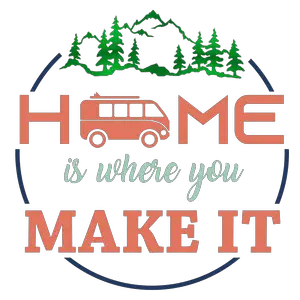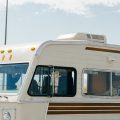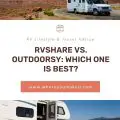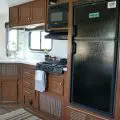Hey! This site is reader-supported and we earn commissions if you purchase products from retailers after clicking on a link from our site.
When renting an RV for a vacation, whether it’s for a few days, several weeks, or even months, can be costly. In this guide, we’ll look at the cost of these expensive and cheap RV rentals based on RV sizes and I’ll also share some of my ideas for keeping many of the additional costs down to a minimum when you’re traveling on your next voyage while you’re RVing throughout whatever continent you may be traversing.
Table of Contents
- What Are My RV Rental Options?
- What Are My Options When Choosing an RV Rental in Terms of Pricing?
- Are There Other Fees Associated With Renting an RV When Using Outdoorsy?
- How Is the Payment for the Rental Structured?
- What Do You Think, Is It Worth the Cost?
- Final Thoughts
What Are My RV Rental Options?
The most common types of RV rentals are the models listed below.
Pop-Up Camper
This type of camper is towed behind your car or truck as they are usually very lightweight and short in length. This RV requires some setup because the top part of the unit is cranked up and down either manually or with built-in motors.
Since the top half of the camper needs to be collapsible, this part of the camper generally has canvas sides and ends that are supported by plywood bases that pull in or out to supply sleeping berths. As a rule, this type of camper will sleep two people in each berth and the dining table can be dropped down to add sleeping for an additional two people. These units come equipped with a small stove, sink, and sometimes a small 12-volt or propane refrigerator.
As for restrooms or bathing facilities, these units don’t have those amenities and most people who camp in this style of RV do so in campgrounds where modern or primitive facilities are provided. Finally, since these pop-up campers have canvas sides and end, don’t expect air-conditioning and while I have seen them equipped with small furnaces, they are not suitable for use in extreme climates.
Campervans
While some people may refer to these RVs as class “B” rigs, they are not. Usually, a campervan is too small to stand up in (although some do have roof toppers making their interior taller). Since these are limited in terms of space, they too are usually equipped with a small stove, sink and refrigerator, and a sleeping area suitable for two people. Many of these are equipped with small furnaces and AC units as well.
Travel Trailers
This category can encompass a diverse selection of units. You’ll find that travel trailers vary mostly by length and weight so it’s important that you understand the towing capacity of your tow vehicle.
With that said, travel trailer rental provides amenities such as cooking facilities and living spaces will also vary according to length. For example, in a 15 ft. to 20 ft. trailer, you might find that the unit is equipped with a two-burner stove, a small refrigerator, and a small sink. It might also include a small restroom that serves as a combined commode and shower whereas a larger trailer would have bigger bathroom facilities with areas to keep your towels and bath products inside the restroom.
The same can be said for the kitchen area and the living quarters. It’s likely that your larger trailers will include bigger stove tops and an oven, a kitchen sink with two basins, and even a full-size refrigerator like those you would find in a permanent home or apartment.
Also, larger units often include slide-outs, and this expands your living spaces exponentially, making them wider and roomier. Another benefit to the bigger units is more cupboards, closets, and storage bays for additional outdoor gear such as a grill and folding chairs or a table.
Fifth Wheel Trailers
Some folks prefer to rent out 5th wheels for their vacations too. While these units pull nicely down the road, they do require a larger tow vehicle and a special hitch that is semi-permanently installed in your truck bed which can be problematic if you don’t have one at the time of your RV rental. Most people that rent these units have them delivered to where they plan to camp prior to their arrival, which I will address later in this article.
Another drawback to staying in a 5th wheel model and you pay extra to have it set up and delivered is dealing with your black and gray water tanks. If you’re going to stay in it for over a couple of weeks, it’s likely that these tanks will need to be emptied during your stay.
In this case, you’ll have to pay extra for the RV owners of the unit to move it to the campground dump station to empty the tanks. If you don’t have the means to move the fifth wheel on your own these additional costs can add up, so it would be in your best interest to choose a campground that has full hook-ups that include sewage.
Toy Haulers
These types of campers are popular for those people who want to bring along all-terrain vehicles, motorcycles, a golf cart, bicycles, or a combination of these motorized toys. While these work for those that don’t what to drive another vehicle with a utility trailer that carries your toys, the downside to this unit is that what you gain in space to haul the toys, you lose in living space.
Class “B” Motorhomes
The smallest of motorhome rentals, class B RVs are usually panel vans that have been converted into a motorhome. Bigger than campervans, many have compact restrooms, a small cooking area, and a bed in the rear suitable to sleep two people with ample storage underneath it for camping gear and luggage.
Class “C” Motorhomes
The next size-up motorhome is class C RVs. As a rule, you can expect a small bedroom in the rear of this type of RV, a small living area, a bed over the driver’s compartment, and a kitchen with a drop-down dining table that converts into a bed and accommodates two more campers.
These units also include a restroom, storage space below the living spaces as well as closets, and cupboards inside. Typically, these are designed for two people, but with the cab-over bunk and dining table, they can accommodate up to six people.
Class “A” Motorhomes
When it comes to motorhomes, class A RVs are the largest class you can get. They will have everything your “B” class has, but they will be much roomier with many added amenities such as motorized awnings, automatic leveling systems, entertainment systems ample slide-outs.
By far, these are the most luxurious of your options, but it’s likely that you’ll need to have a tow dolly to bring your personal vehicle with you so you can explore away from your camping site while you’re on the road.
Where Can I Find an RV to Rent?
There are numerous places to rent an RV such as dealerships, craigslist, internet searches and even reaching out to people you know that like to go RVing. However, one source I recommend is the website Outdoorsy.
These folks are worldwide, and they operate much the same way as the people at Airbnb do. Basically, they’re a peer-to-peer site that puts renters in touch with private RV owners who are willing to rent rigs to you based upon the area you wish to travel to or from, the size and type of unit you’re interested in renting, as well as numerous other factors such as the average price you’re willing to pay for the RV rentals and travel dates too.
The website is easy to navigate and you’ll find thousands of listings here in the United States and abroad.
Make sure to check out Mike’s guide on the best RV rental companies for more details on Outdoorsy, RVshare, Cruise America, and other RV rental options.
What Are My Options When Choosing an RV Rental in Terms of Pricing?
| Type of RV Rental | RV rental prices under 10 Years Old | RV rental prices over 10 Years Old |
|---|---|---|
| Pop-up Campers | $50 to $100 per day | $50 to $100 per day |
| Campervan | $75 to $125 per day | $50 to $125 per day |
| Travel Trailer | $125 to $200 per day | $75 to $125 per day |
| Fifth Wheel Trailer | $125 to $200 per day | $85 to $125 per day |
| Toy Hauler Trailer | $125 to $200 per day | $125 to $200 per day |
| Class “B” Motorhome | $200 to $350 per day | $125 to $200 per day |
| Class “C” Motorhome | $225 to $400 per day | $150 to $225 per day |
| Class “A” Motorhome | $300 to $450 per day | $185 to $300 per day |
Since the owners of the RVs set the RV rental prices, you’ll see that they vary widely. However, the general theme is that the bigger they are in size, the more they cost. You also must consider whether you wish to have a long-term RV rental.
Are There Other Fees Associated With Renting an RV When Using Outdoorsy?
Yes, many owners charge fees for mileage, rental insurance, generator usage, pets, and various other factors. For example, when I reviewed their site, I noticed that most owners charged $45 a day for liability insurance and many folks charged mileage fees for driving over a certain mileage a day.
These can range from .25 cents a mile to .75 per mile depending upon the terms you agree to when you contact the RV owner. And before you ask how would they know how far you drive per day, most people have GPS trackers installed on their rigs so they know exactly the distance you travel daily and where you are camping and they use this to keep track of your mileage it also helps to prevent theft if people decide they don’t what to return a rig.
How Is the Payment for the Rental Structured?
These have a lot of variables and I’ll try to explain them as best I can. Let’s start with mileage as that can be very confusing. For example, you live in Tampa, Florida and you want to drive to the Grand Canyon. The distance between the two places is 2,144 and the travel time is two days if you drove straight through.
This means that your round-trip mileage cost would be $1,500 less the four days of free 150 miles per day or $210 which brings your mileage total down to $1,290.
Now, let’s look at your daily RV rental prices. We’ll say the RV you chose has a cost of $150 and you’re planning on traveling for two weeks. That makes your RV rental fee $2,100. Now we’ll add the daily rental insurance at $45 which will cost you an additional fee of $630. And finally, you’ll be required to pay a security deposit of $1,000. These represent your upfront costs for a grand total of $5,020.
If for some reason you decide to cancel your trip with a seven-day advanced notice, then your security deposit is returned to you. The remaining balance of $4,020 is charged to you when you pick up your RV rental. Additional fees such as a pet fee will also be applied at this time as is a cleaning deposit and those will also vary upon your RV rental contract. Yes, some renters charge cleaning fees.
On the upside, if you return your RV rental early with less mileage than was calculated then your daily, rental insurance, and mileage will be prorated, and the difference will be refunded back to you.
Now, where do you plan to camp along your journey? If you’re staying in campgrounds, let’s be conservative and say that your campsite costs will be $60 nightly, and you’ll stay in the campgrounds for 10 nights. That’s another cost of $600. Let’s also add in $300 for food, and of course fuel at a cost of $780 based on your vehicle getting 15 miles per gallon @ $2.50 per gallon.
RV rental fee, $2,100
Mileage, $1,290
Liability insurance, $630
Deposit, $1,000
Fuel, $780
Food, $300
Campground fees, $600
RV park fee, entertainment, $300
Subtotal, $7,000
-$1,000 deposit
Grand total, $6,000
What Do You Think, Is It Worth the Cost?
I based a lot of these costs on traveling with a family of four. Most travel experts will tell you to plan on a cost of $150 per person per day when staying in hotels, rental car and food, beverage and entertainment costs, and even more if you’re planning on visiting theme parks. That cost would come to $8,400 so if you’re conservative you could trim this down a bit more, but either way, it’s going to be costly for a 14-day trip.
Final Thoughts
If you were planning on this road trip to be a once-in-a-lifetime experience for you or your family, it may be worth the cost. However, if you’re planning on doing this type of trip annually, it may not be in your best interest to spend this kind of money.
Personally, I would consider shopping for an RV that fits your or your family’s interests and needs. Even if you’re financing an RV, in the long run, it’s likely that it will save money over time and you can save mileage costs as well as daily RV rentals fees and daily insurance fees. For example, my annual full coverage insurance cost on my 5th wheel is approximately $160. Those big savings when you compare it to a daily fee of $45.
Also, finance companies tend to keep their contracts on RVs to longer terms because they know that many people can’t afford to pay off a $25,000 RV in five years when they have home mortgages and vehicle loans to pay as well.
For me, I could fly to Bangkok, Thailand, rent a luxury condo in a high-rise skyscraper for $500 a month, eat out every night, have maid service, use a gym and business center as well as cover my ground transportation and entertainment and still come home after three months with $2,000 in my pocket.
Would I travel from Tampa, FL to the Grand Canyon National Park and back for a 14-day excursion at a cost of $6,000? Absolutely not. But then again, I prefer boondocking in the great outdoors and I’m always on the hunt for quiet fishing holes too.
As always my friends, stay safe, have fun and I wish you healthy travels.




